Happy New Year! We hope everyone enjoyed a lovely holiday season! Are you ready for all that 2020 brings? As you look forward to what the new year holds, be sure to look back on all your accomplishments from this past year. In this newsletter edition, we celebrate some of the great achievements of our volunteers over the last few months of 2019. Join us in celebrating the work they've done and check out our Upcoming Events section to help us do even more this year!
— the FWC's Volunteer Program Team
Welcome Simon Fitzwilliam!
Simon Fitzwilliam (left), with FWC staff, at his first outreach event, the Ocean Beach Reef Fest at Satellite Beach, to recruit volunteers interested in shorebird conservation. Photo courtesy of Simon Fitzwilliam.
We are so excited to welcome Simon Fitzwilliam to the FWC’s Volunteer Program Team! Simon will serve as the Volunteer Program Biologist for the Northeast Region. Simon has worked on several wildlife conservation projects in diverse ecosystems such as the rangelands of south-central Florida, the Ocala National Forest, the Florida Everglades, the Nature Coast and the Red Hills region of the Panhandle. Between working seasonal wildlife positions in the winters, Simon spent five summers as a naturalist guide at a backcountry lodge in Alaska. Simon is now back in Florida year-round and is very excited to be fostering stewardship and community engagement in the FWC’s Northeast Region.
If you are interested in learning more about volunteering in the NE Region with Simon, visit our website.
New Homes for Wood Ducks

Volunteers in the Northwest Region were hard at work making lots of new wood duck nest boxes this winter! Photo by FWC staff.
Volunteers helped to construct new wood duck nest boxes for the Fitzhugh Carter Tract of Econfina Wildlife Management Area (WMA). This area was affected by Hurricane Michael in late 2018, leaving the current nest boxes in less-than-ideal condition. Seventeen new boxes were made to replace the current ones and provide a safe place for wood ducks to nest. A huge thank you to the volunteers who helped with this effort!

Seventeen beautiful new wood duck boxes are ready to be installed around the ponds and wetlands of the Fitzhugh Carter Tract of Econfina WMA. Photo by FWC Staff.
Jay Watch Recognition Event

Jay Watchers enjoyed a delicious cake at the recognition event. Photo by FWC staff.
Audubon Florida coordinates the statewide Jay Watch Citizen Science Program. The FWC partners with Audubon Florida to assist in the recruitment of volunteers for this program, who undertake surveys of scrub-jays across Florida. The information collected during surveys is used by land managers to assess management efforts in protecting this Federally-designated Threatened species.
On November 23, Audubon Florida held the Jay Watch annual volunteer recognition event at Archbold Biological Station to thank the volunteers involved in the program. After an informative hike through the Florida scrub led by Dr. Reed Bowman (Archbold Biological Station), presentations were provided by a range of excellent speakers. Cheryl Millet (The Nature Conservancy) provided a historical recap of the Jay Watch Program. Dr. Marianne Korosy (Audubon Florida) presented on the population trends of the Florida scrub-jay, which was followed by a presentation from Dr. Karl Miller (FWC) on the intricacies of scrub-jay translocations. The day celebrated all the efforts of the volunteers who make this program possible.
Pet Amnesty Day
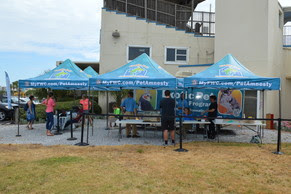
Volunteers helped set up for the event and ensure everything ran smoothly. Photo by FWC staff.
The FWC’s Exotic Pet Amnesty Program aims to reduce the number of exotic and nonnative pets that are released into the wild. On October 12, five volunteers assisted with a Pet Amnesty Day in Fort Walton Beach. Volunteers helped set up, greet guests, track paperwork and take photos. In total, 43 pets including ball pythons, sugar gliders, box turtles and more were surrendered and subsequently adopted by new permitted owners! Thanks to all the volunteers that helped make this event a success!
Successful Trash Removal

Volunteers proudly show the efforts of removing trash from the Big Pine Tract of the Chinsegut Wildlife and Environmental Area in Brooksville. Photo by FWC staff.
In December, a group of volunteers assisted staff at the Big Pine Tract of the Chinsegut Wildlife and Environmental Area to remove trash from the drainage leading to Burn’s Prairie. Volunteers collected and removed 1,060 pounds (0.53 tons) of trash. Most of the trash consisted of glass bottles, plastic, cans, old buckets and discarded piles of wood. Disposing of trash properly can help protect fish and wildlife as debris and litter pose a high risk of entanglement and ingestion. Several volunteers also hand pulled invasive plant species including Caesar’s weed and coral ardisia.
It Takes a Village

Volunteers from the FWC’s Shorebird Program, Audubon Florida and Panama City Beach Turtle Watch pause for a photo during a volunteer appreciation event in October. Photo courtesy of Bonnie Samuelsen, Audubon Florida.
As you have probably experienced, the beaches in Florida are very busy in the summer time! Not only are lots of humans taking advantage of Florida’s esteemed beaches, so too are beach-nesting birds and sea turtles. It takes a collaboration of many organizations and agencies, as well as many dedicated individuals, to ensure the protection and conservation of these important species. For example, in Panama City Beach, Florida, the FWC is joined by Audubon Florida and Panama City Beach Turtle Watch to protect beach-nesting birds and sea turtles and to educate beachgoers on all beach-nesting species. In the fall, the three groups held a volunteer appreciation event to gather together and celebrate another great year of collaboration and successful nesting! Collaborations such as this are essential to the conservation of Florida’s native species.
Balsam Apple Removal

The Ridge Rangers removed a significant amount of invasive balsam apple from the FWC’s Carter Creek Tract. Photo by Tessie Offner, FWC staff.
The Ridge Rangers dedicated 95 hours of cumulative work in October and December pushing back the invasion front on the Carter Creek Tract of the Lake Wales Ridge (LWR) Wildlife and Environmental Area by removing balsam apple. Balsam apple is an invasive vining plant, brought to the United States as a culinary and medicinal crop. It is easy to spot the ripe fruits of this plant, which are bright orange with fleshy red seeds. When left to grow unimpeded in natural areas, its extensive vines can overcome native plant species and shade out smaller plants. The work the Ridge Rangers completed will allow for future successful restorative fires and create habitable areas for rare and endangered Florida plants, 28 of which are known to occur on the site. As we look ahead to 2020, we hope to continue to make significant gains towards removing balsam apple from this area!
| 












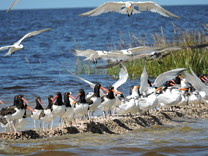

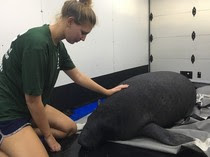


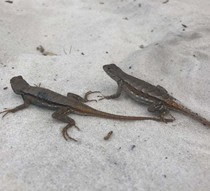
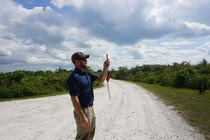


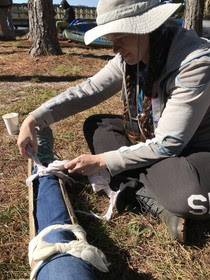
No comments:
Post a Comment